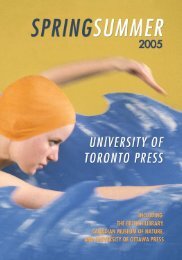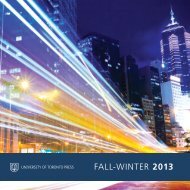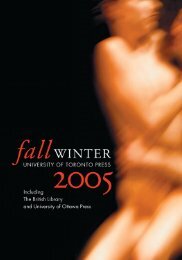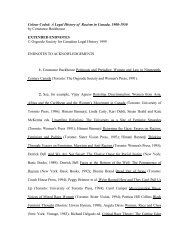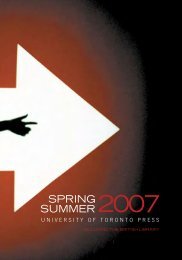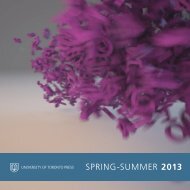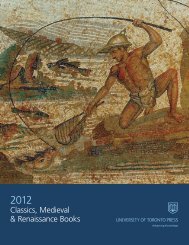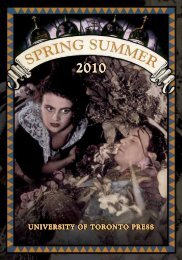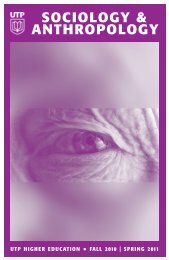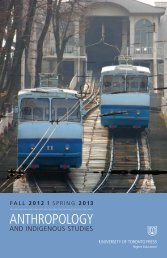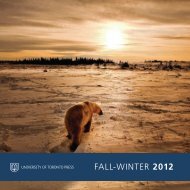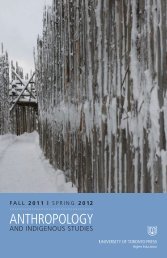Fall/Winter 2006 - University of Toronto Press Publishing
Fall/Winter 2006 - University of Toronto Press Publishing
Fall/Winter 2006 - University of Toronto Press Publishing
You also want an ePaper? Increase the reach of your titles
YUMPU automatically turns print PDFs into web optimized ePapers that Google loves.
L I T E R A R Y S T U D I E S<br />
The Great Code<br />
The Bible and Literature<br />
Northrop Frye<br />
Edited by Alvin A. Lee<br />
COLLECTED WORKS OF NORTHROP FRYE, VOLUME 19<br />
Considered by many to be Northrop Frye’s magnum<br />
opus, The Great Code (1982) reflects a lifetime <strong>of</strong><br />
thinking about the patterns and meanings <strong>of</strong> the<br />
Bible. In this new edition <strong>of</strong> The Great Code, Alvin A.<br />
Lee presents a corrected and fully annotated version<br />
<strong>of</strong> Frye’s text, as well as a comprehensive introduction<br />
to help contextualize this important work and guide<br />
readers through its allusive passages. Lee’s introduction<br />
provides a synoptic account <strong>of</strong> the role <strong>of</strong> the Bible<br />
in Frye’s intellectual and spiritual odyssey, as well as<br />
a description <strong>of</strong> how The Great Code as a book came<br />
into existence, and an introductory critique <strong>of</strong> the<br />
shape and meaning <strong>of</strong> the book’s argument.<br />
The Great Code is culturally allusive to a high<br />
degree. It takes much <strong>of</strong> its inspiration from the<br />
Bible itself, including a pr<strong>of</strong>usion <strong>of</strong> biblical passages,<br />
but also from the author’s extensive reading<br />
<strong>of</strong> a host <strong>of</strong> other texts from ancient times until the<br />
late twentieth century. Lee’s extensive annotation<br />
illustrates, beyond question, that Frye’s knowledge<br />
<strong>of</strong> the Bible and how it has worked in Western<br />
culture was at once pr<strong>of</strong>ound and visionary. This<br />
new edition not only re-presents Frye’s text in a<br />
clear, correct, and fully annotated form, it goes a<br />
long way in helping us understand the widespread<br />
scholarly and popular reception that met this<br />
extraordinary and in some ways revolutionary book<br />
and how it can still be richly rewarding for readers.<br />
Alvin A. Lee is a pr<strong>of</strong>essor emeritus in the Department<br />
<strong>of</strong> English at McMaster <strong>University</strong>, a research<br />
associate at Victoria College in the <strong>University</strong> <strong>of</strong><br />
<strong>Toronto</strong>, and general editor <strong>of</strong> the Collected Works<br />
<strong>of</strong> Northrop Frye.<br />
Northrop Frye’s Notebooks<br />
on Renaissance Literature<br />
Edited by Michael Dolzani<br />
COLLECTED WORKS OF NORTHROP FRYE, VOLUME 20<br />
Although Northrop Frye’s first book, Fearful<br />
Symmetry (1947), elevated the reputation <strong>of</strong> William<br />
Blake from the status <strong>of</strong> a minor eccentric to that<br />
<strong>of</strong> a major Romantic poet, Frye in fact saw Blake as<br />
a poet (and, consequently, himself as a critic) not<br />
<strong>of</strong> the Romantic period, but <strong>of</strong> the Renaissance.<br />
As such, Frye’s meditations on the Renaissance are<br />
particularly valuable. This volume collects six <strong>of</strong><br />
Frye’s notebooks and five sets <strong>of</strong> his typed notes on<br />
subjects related to Renaissance literature.<br />
Michael Dolzani divides these notes into three<br />
categories: those on Spenser and the epic tradition;<br />
those on Shakespearean drama and, more widely, the<br />
dramatic tradition from Old Comedy to the masque;<br />
and those on lyric poetry and non-fiction prose.<br />
The organization <strong>of</strong> this volume reflects ‘a comprehensive<br />
study <strong>of</strong> Renaissance Symbolism’ in three<br />
volumes, which Frye proposed to the Guggenheim<br />
Foundation in 1949. Frye received a Guggenheim<br />
fellowship, but never wrote the book; nevertheless,<br />
his application, part <strong>of</strong> which is also included here, is<br />
an important document. The Guggenheim application<br />
not only reveals the outlines <strong>of</strong> Frye’s thinking<br />
about literature, it also uncovers his plans for his<br />
future creative life during the crucial period between<br />
his completion <strong>of</strong> Fearful Symmetry and his absorption<br />
in the writing <strong>of</strong> Anatomy <strong>of</strong> Criticism.<br />
In addition to providing insight into Frye’s<br />
thinking process, the material collected into this<br />
key volume in the Collected Works is <strong>of</strong> particular<br />
importance because much <strong>of</strong> it has no direct counterpart<br />
in any <strong>of</strong> Frye’s other published works.<br />
Michael Dolzani is a pr<strong>of</strong>essor in the Department <strong>of</strong><br />
English at Baldwin Wallace College.<br />
Approx. 464 pp / 6 x 9 / July <strong>2006</strong><br />
1 illustration<br />
Cloth ISBN 0-8020-9120-2 / 978-08020-9120-8<br />
£65.00 $100.00 E<br />
Approx. 608 pp / 6 x 9 / December <strong>2006</strong><br />
Cloth ISBN 0-8020-9179-2 / 978-0-8020-9179-6<br />
£65.00 $100.00 E<br />
32



